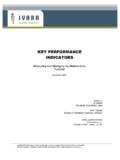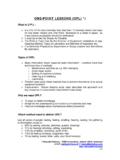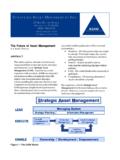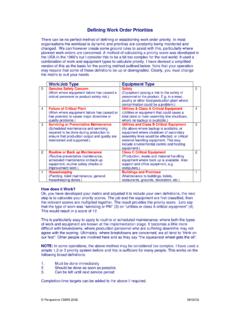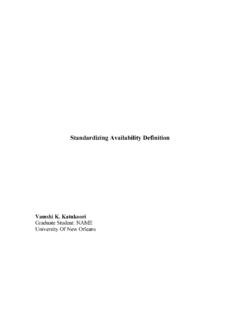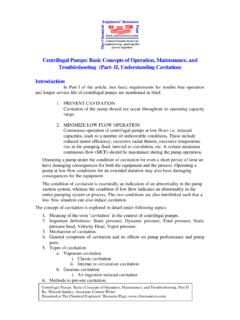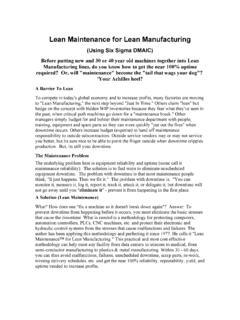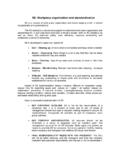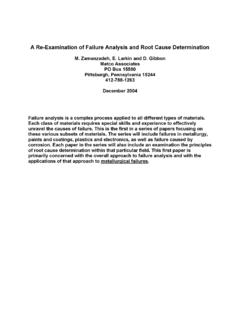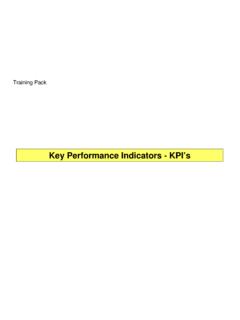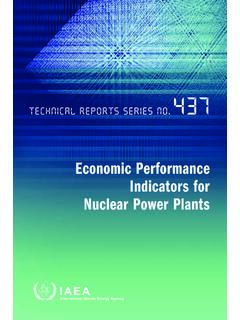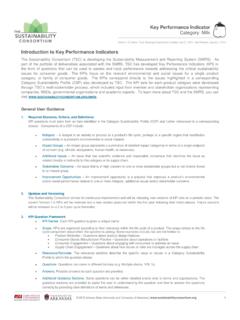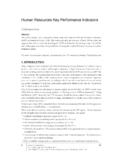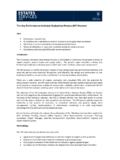Transcription of Using Performance Measures to ... - plant …
1 Using Performance Measures to Drive Maintenance Improvement By Sandy Dunn, Director, Assetivity Pty Ltd Summary Many people and many organisations are struggling to develop Performance Measures that effectively drive Performance improvement. They are often wading under the ad-hoc morass of inherited, legacy Key Performance indicator (KPI) and Performance reports. The bureaucracy involved in producing, analysing and reporting on these Performance Measures has taken over from effective, action-oriented Maintenance Improvement, and the purpose behind the production of the KPIs has been lost. This paper discusses eight essential elements necessary for a successful Performance measurement system, and in doing so it outlines a possible method that could be used to redefine, and refocus, Performance reporting in order to motivate the organisation towards higher levels of Maintenance Performance . Keywords Performance Measurement, Key Performance Indicators, KPIs, Balanced Scorecard, Performance Improvement Element 1 Create an Inspiring Vision Why are we measuring Performance at all?
2 The only valid reason for measuring Performance is to see whether we are making progress towards a specific long-term goal. At a personal level, that goal could be the achievement of some financial security to obtain enough money to be able to afford that dream home, or to be able to afford to send your children to a good private school, or to be able to enjoy a comfortable retirement. Or it could be less tangible the achievement of some personal satisfaction, or recognition for work well done. However these goals are highly personal, and also inspirational they are something we really want to achieve. At an organisational level, organisational vision and mission statements are, almost without exception, completely uninspiring. They do little to generate a sense of purpose, or a sense of excitement amongst members of the organisation. Typically, most organisational mission or vision statements look something similar to the following: Extracted from BHP Billiton Charter, 29 June 2001 Our purpose is to create value through the discovery, development and conversion of natural resources, and the provision of innovative customer and market-focused solutions.
3 To prosper and achieve real growth, we must: Actively manage and build our portfolio of high quality assets and services. Continue the drive towards a high Performance organisation in which every individual accepts responsibility and is rewarded for results. Earn the trust of employees, customers, suppliers, communities and shareholders by being forthright in our communications and consistently delivering on commitments. If you worked for BHP Billiton, would this inspire you to great things? On the other hand, look at some of the other vision statements that some of the world s leading organisations have used1. To experience the joy of advancing and applying technology for the benefit of the public (Sony) To make people happy (Walt Disney) To solve unsolved problems innovatively (3M) To experience the emotion of competition, winning and crushing competitors (Nike) What do you notice about these Vision Statements?
4 A number of things they are: Short Simple Inspirational, and Focused less on what will provide benefits to the organisation, and more on what will provide benefits to the individuals within the organisation (although, obviously, it is hoped that the two are closely linked) If you wish to create a high- Performance organisation, then it is essential that all members of the organisation are focused on achieving the same goal and the simpler, more focused, and more inspirational the goal, then the greater the chance that it will be achieved. And, more importantly, this vision will form the basis for deciding on what is important to your business, and, therefore, which Measures you should be reporting. 1 Ref: Collins Harvard Business Review Sep/Oct 1996 Element 2 - Use a Small Number of Easily-Understood Performance Measures When it comes to Performance Measures , less is definitely more!
5 Many organisations are buried in Performance Measures , for legacy and historical reasons, but the purpose behind these Performance Measures and reports is often forgotten. The only valid, productive use for Performance Measures in any organisation is to motivate action which improves organisational Performance . Performance Measures are a means to an end they are the means by which organisational Performance , through effective action, can be improved. Yet, in many organisations, the production and analysis of Performance Measures acts as an end in its own right. I suggest that you try the following, simple exercise at your work place. First, collect all of the daily, weekly, monthly, quarterly and annual reports that are produced on a regular basis. Include shift logs and reports, shift production reports, cost reports, schedule Performance reports any report that records or explains Performance that is produced by, issued by, or received by anyone in the Maintenance function from tradesperson all the way up to manager.
6 If these are electronic in format, print them out. I bet you will be surprised by the number and size of reports that are produced. I am prepared to bet that the resulting pile of paper will be substantial! Finally, consider how much time and effort has gone into collecting and calculating the data for these reports. Think about how much time and effort has gone into the considered analysis and explanation of the results contained in these reports. And then think about how much effective action has resulted from the issue of these reports. Simply performing this exercise frequently identifies significant opportunities to either: Eliminate reports completely, or Significantly reduce the size of reports Further, the more Performance reports and Performance indicators you have, the greater is the risk that two or more indicators reported in different reports will contradictory each other. This can come about either because: The same Performance indicator is reported in two or more reports, but the definitions of these indicators are different, or they use different data sources, or Similar Performance indicators are used which present the same concept in a slightly different manner.
7 An example of the first situation is often the case when Equipment Reliability data (Mean Time Between Failures MTBF) is reported from both the Maintenance Management System, and from a Process Control (Production) System. Typically, the Maintenance Management system will only record a failure event for each unplanned event for which a work order has been raised within the CMMS. However, the Process Control system will record a failure event for ALL unplanned stoppages due to maintenance, regardless of whether a Work Order was raised or not. The result is different reported figures for MTBF. As a direct consequence of this, often a significant amount of time and effort is spent in trying to reconcile the two different figures, and in attempting to solve the problem of different data. All of this time or effort is distracting decision makers from the main task of actually taking appropriate corrective action, if required, to bring Performance back on track.
8 An example of the second case, that often applies in capital intensive industries, is where Maintenance costs are reported against budget both on a simple cost basis, and on a unit cost ($ per unit of output). Frequently, in capital intensive industries, a large portion of costs are fixed on a monthly basis, regardless of the total production output of the plant . As a result, when production is above budget for any particular month (usually not as a direct result of any maintenance action), then Unit Costs are below budget. However because some costs typically DO vary directly with production output, then often Costs (in total $ terms) will be above budget for that particular month. So, in this case, depending on which measure is used (Total Costs, or Unit Costs), the monthly cost Performance in a high production month can be interpreted as being either better than, or poorer than, budget. And of course the reverse is true in a low production month.
9 Once again, in this case, considerable time and effort can be wasted debating whether Performance really is good or bad diverting attention from other, more important matters. Element 3 A balanced set of Measures is essential Many of you have probably heard of the balanced scorecard, and some of you may well have a balanced scorecard in place at your organisation but specifically how does this apply to maintenance? The concept of the Balanced Scorecard was introduced by Kaplan and Norton in the mid 1990 s. Specifically, they consider that an effective Performance reporting system should focus on Performance from four key perspectives: The Owner/Shareholder s view of your business The Customer s view of your business Internal Processes The Learning Organisation This all makes sense from a total business point of view, but requires some further consideration when translating this concept into something practical at lower levels within the organisation particularly when we consider, as we will in the next Element, that different Performance indicators may be appropriate for different positions, job roles, and even individuals within the organisation.
10 In general terms, when considering these four elements with respect to maintenance, I have found it useful to conceptualise them as follows: Owner/Shareholder s view consider Performance indicators that relate to financial Performance , or exposure to risk (safety Performance , for example). These are the areas of Performance that those with a financial stake in the business are most likely to be interested in. Customer s view if we consider Production to be Maintenance s customer (a dangerous and one-sided view, in my opinion but that is a topic for a future paper, not one that there is enough time to consider now), then we may consider Measures that Production may be interested, such as equipment Performance , on-time delivery of service, quality of workmanship etc. Internal Processes these are Measures of the Performance of the internal management processes within the Maintenance function.
